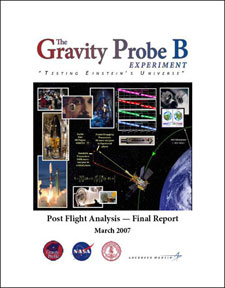GP-B News — Winter 2007
THE GP-B DATA ARCHIVE AT THE NSSDC
Early this past July, we finished delivering an archive of raw GP-B data to the National Space Science Data Center (NSSDC) at the Goddard Space Flight Center in Greenbelt, MD. Since that time, the staff at the NSSDC has been processing and integrating the GP-B data into the NSSDC data archives.
- Click Here to view the GP-B data catalog record at the NSSDC, showing the current status of the GP-B data archive.
The data we recently sent to the NSSDC is classified as "Level 2 Science Instrument Source Data." This means that the data has been lightly processed. In other words, the individual data elements have been separated out from the compressed format in which the data was telemetered back to Earth, and they have been tagged and entered into a database.
You can learn more about how the GP-B data was collected, stored, and processed from two past GP-B updates on our Web site:
- The 14 January 2005 update describes the data collection and telemetering process.
- The 22 July 2005 update describes the data reduction and data analysis process.
A note regarding the Level 2 data currently at the NSSDC: Any results about gyro orientation history (and what it may say about relativity) need to be subsequently processed to calibrate the instrument, remove the effects of vehicle dynamics, aberration, guide star proper motion, small classical torques, and other systematic effects to ultimately make a measurement of general relativity.
We will soon be providinge details on the subsequent Level 3 processing of the data that we have been working on for the past two years, including the measurements of general relativity that we have seen with this system. We will also be providing a GP-B Data Dictionary--kind of a Rosetta Stone that will enable people who are interested to understand what the various data elements are and how they are inter-related.
Without the data dictionary, the Level 2 raw data is not particularly useful. When the data dictionary and the Level 3 processed data are added to the archive, it will be possible for people outside GP-B to perform further analysis on the data.
GP-B POST-FLIGHT ANALYSIS—FINAL REPORT TO NASA
Among the many projects we have been working on as the GP-B program approaches completion is our final Post Flight Analysis report to NASA. We began compiling some sections of this 616-page document while the GP-B experiment was still in progress. However, it has taken two more years to complete the final edits and prepare this report for public distribution.
Ultimately, this report will be assigned an official NASA document number and entered into the NASA Technical Reports server at the NASA Center for AeroSpace Information (CASI). In the meantime, we have posted the full report on our GP-B Web server in Adobe Acrobat PDF format for public viewing/downloading.
There are two versions of the report on the server:
- A highly-compressed, 12 MB screen viewable version. (Note: You can print pages from this version, but they will have very low-quality images.)
- A moderately-compressed, 29 MB printable version. (Note: Pages from this version will print acceptably on an ink jet or laser printer.)

